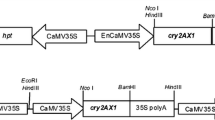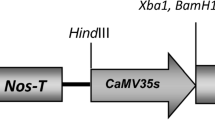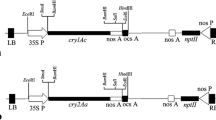Abstract
Modified cry1Ca5 and cry1Ba1 genes, under the transcriptional control of a CaMV 35S promoter, were individually transferred into potato (Solanum tuberosum L.) cv. Iwa using Agrobacterium-mediated transformation. Thirty-six and thirty-eight independently derived cry1Ca5- and cry1Ba1-transgenic plants were regenerated respectively. Multiplex-PCR confirmed the presence of the nptII selectable marker gene and the specific cry gene in all regenerated lines. In greenhouse experiments, approximately 90% of each transgenic population produced phenotypically normal plants. More than 90% of the cry1Ca5-transgenic lines gave 100% larval mortality of potato tuber moth (PTM), Phthorimaea operculella (Zeller), on excised greenhouse-grown leaf and tuber bioassays. In contrast, only 40–50% of the cry1Ba1-transgenic lines gave 50 to 100% of larval mortality of PTM using the same bioassays, although all lines except one significantly inhibited larval growth. Southern blot analysis for eight selected cry1Ca5-transgenic lines revealed that they contained 1 to 6 copies of the cry gene. The amount of Cry1C protein, quantified by ELISA, ranged from 0.26 to 8.42 μg per g of leaf tissue and from 0.23 to 1.02 μg per g of tuber tissue. No relationship was apparent between cry1Ca5 gene copy number and amount of Cry protein expressed in leaves and tubers. Southern blot analysis for seven selected cry1Ba1-transgenic lines revealed that they contained 2 to 8 copies of the cry1Ba1 gene. Both the cry1Ca5 and cry1Ba1 genes offer additional sources of resistance that can be deployed with other effective cry genes to control tuber moth in potatoes.
Similar content being viewed by others
References
Bernatzky R, Tanksley SD (1986) Genetics of actin-related sequences in tomato. Theor Appl Genet 72:314–339
Beuning LL, Mitra DS, Markwick NP, Gleave AP (2001) Minor modifications to the cry1Ac9 nucleotide sequence are sufficient to generate transgenic plants resistant to Phthorimaea operculella. Ann Appl Biol 138:281–292
Bohorova N, Frutos R, Royer M, Estanol P, Pacheco M, Rascon Q, McLean S, Hoisington D (2001) Novel synthetic Bacillus thuringiensis cry1B gene and the cry1B-cry1Ab translational fusion confer resistance to southwestern corn borer, sugarcane borer and fall armyworm in transgenic tropical maize. Theor Appl Genet 103:817–826
Breitler J-C, Marfa V, Royer M, Meynard D, Vassal J-M, Vercambre B, Frutos R, Messeguer J, Gabarra R, Guiderdoni E (2000) Expression of a Bacillus thuringiensis cry1B synthetic gene protects Mediterranean rice against the striped stem borer. Plant Cell Rep 19:1195–1202
Breitler J-C, Vassal J-M, Catala MM, Meynard D, Marfa V, Mele E, Royer M, Murillo I, Segundo BS, Guiderdoni E, Messeguer J (2004) Bt rice habouring cry genes controlled by a constitutive or wound-inducible promoter: protection and transgene expression under Mediterranean field conditions. Plant Biotechnol J 2:417–430
Cañedo V, Benavides J, Golmirzaie A, Cisneros F, Ghislain M, Lagnaoui A (1999). Assessing Bt-transformed potatoes for potato tuber moth, Phthorimaea operculella (Zeller), management. In: Program Report 1997–98, Impact on a Changing World (pp. 161–170). International Potato Centre (CIP), Lima, Peru
Cao J, Tang JD, Strizhov N, Shelton AM, Earle ED (1999) Transgenic broccoli with high level of Bacillus thuringiensis Cry1C protein control diamondback moth larvae resistant to Cry1A or Cry1C. Mol Breed 5:131–141
Chakrabarti SK, Mandaokar AD, Pattanayak D, Chandla VK, Kumar PA, Naik PS, Sharma RP 2000. Transgenic potato lines expressing a synthetic cry1Ab gene acquired tolerance to both potato tuber moth and defoliating caterpillar. In: Khurana SMP, Shekhawat GS, Singh BP, Pandey SK (eds) Potato, global research & development. Indian Potato Association, Shimla
Cho HS, Cao J, Ren JP, Earle ED (2001) Control of Lepidopteran insect pests in transgenic Chinese cabbage (Brassica rapa ssp. pekinensis) transformed with a synthetic Bacillus thuringiensis cry1C gene. Plant Cell Rep 20:1–7
Christey MC, Braun RH, Conner EL, Reader JK, White DWR, Voisey CR (2006) Cabbage white butterfly and diamond-back moth resistant Brassica oleracea plants transgenic for cry1Ba1 or cry1Ac5. Acta Hortic 706:247–253
Christov NK, Imaishi H, Ohkawa H (1999) Green-tissue-specific expression of a reconstructed cry1C gene encoding the active fragment of Bacillus thuringiensis delta-endotoxin in haploid tobacco plants conferring resistance to Spodoptera litura. Biosci Biotechnol Biochem 63:1433–1444
Conner AJ, Christey MC (1994) Plant breeding and seed marketing options for the introduction of transgenic insect-resistant crops. Biocontrol Sci Technol 4:463–473
Conner AJ, Williams MK, Abernethy DJ, Fletcher PJ, Genet RA (1994) Field performance of transgenic potatoes. N Z J Crop Hort Sci 22:361–371
Davidson MM, Jacobs JME, Reader JK, Butler RC, Frater CM, Markwick NP, Wratten SD, Conner AJ (2002) Development and evaluation of potatoes transgenic for a cry1Ac9 gene conferring resistance to potato tuber moth. J Am Soc Hortic Sci 127:590–596
Davidson MM, Takla MFG, Jacobs JME, Butler RC, Wratten SD, Conner AJ (2004) Transformation of potato (Solanum tuberosum) cultivars with a cry1Ac9 gene confers resistance to potato tuber moth (Phthorimaea operculella). N Z J Crop Hort Sci 32:39–50
Douches DS, Westedt AL, Zarka K, Schroeter B (1998) Potato transformation to combine natural and engineered resistance for controlling tuber moth. HortScience 33:1053–1056
Douches DS, Li W, Zarka K, Coombs J, Pett W, Grafius E, Ei-Nasr T (2002) Development of Bt-cry5 insect-resistant potato lines ‘Spunta-G2’ and ‘Spunta-G3’. HortScience 37:1103–1107
Ebora RV, Ebora MM, Sticklen MB (1994) Transgenic potato expressing the Bacillus thuringiensis CryIA(c) gene effects on the survival and food consumption of Phthorimea operculella (Lepidoptera: Gelechiidae) and Ostrinia nubilalis (Lepidoptera:Noctuidae). J Econ Entomol 87:1122–1127
Fenemore PG (1988) Host-plant location and selection by adult potato moth, Phthorimaea operculella (Lepidoptera: Gelechiidae): a review. J Insect Physiol 34:175–177
Ferré J, Van Rie J (2002) Biochemistry and genetics of insect resistance to Bacillus thuringiensis. Annu Rev Entomol 47:501–533
Frutos R, Rang C, Royer M (1999) Managing insect resistance to plants producing Bacillus thuringiensis toxins. Crit Rev Biotech 19:227–276
Fujimoto H, Itoh K, Yamamoto M, Kyozuka J, Shimamoto K (1993) Insect resistant rice generated by introduction of a modified δ-endotoxin gene of Bacillus thuringiensis. Bio/Technology 11:1151–1155
GenStatCommittee (2003) GenStat Release 7.1 reference manual, parts 1–3. VSN International, Oxford
Gleave AP (1992) A versatile binary vector system with a T-DNA organizational structure conducive to efficient integration of cloned DNA into the plant genome. Plant Mol Biol 20:1203–1207
Gleave AP, Mitra DS, Markwick NP, Morris BAM, Beuning LL (1998) Enhanced expression of the Bacillus thuringiensis cry9Aa2 gene in transgenic plants by nucleotide sequence modification confers resistance to potato tuber moth. Mol Breed 4:459–472
Gould F (1998) Sustainability of transgenic insecticidal cultivars: Integrating pest genetics and ecology. Annu Rev Entomol 43:701–726
Höfgen R, Willmitzer L (1988) Storage of competent cells for Agrobacterium transformation. Nucleic Acids Res 16:9877
Hood EE, Gelvin SB, Melchers LS, Hoekema A (1993) New Agrobacterium helper plasmids for gene transfer to plants. Transgenic Res 2:208–218
Jansens S, Cornelissen M, Clerco RD, Reynaerts A, Peferoen M (1995) Phthorimaea operculella (Lepidoptera: Gelechiidae) resistance in potato by expression of the Bacillus thuringiensis CryIA(b) insecticidal crystal protein. J Econ Entomol 88:1469–1476
Lagnaoui A, Cañedo V, Douches DS (2000) Evaluation of Bt-cry1Ia1 (cryV) transgenic potatoes on two species of potato tuber moth, Phthorimaea operculella and Symmetrischema tangolias (Lepidoptera: Gelechiidae) in Peru. International Potato Centre (CIP) Program Report 1999–2000: 117–121
Li W, Zarka KA, Douches DS, Coombs JJ, Pett WL, Grafius EJ (1999) Coexpression of potato PVY° coat protein and cry V-Bt genes in potato. J Am Soc Hortic Sci 124:218–223
Liu YB, Tabashnik BE, Meyer SK, Crickmore N (2001) Cross-resistance and stability of resistance to Bacillus thuringiensis toxin Cry1C in the diamondback moth. Appl Environ Microbiol 67:3216–3219
Meiyalaghan S, Jacobs JME, Butler RC, Wratten SD, Conner AJ (2006) Expression of cry1Ac9 and cry9Aa2 genes under a potato light-inducible Lhca3 promoter in transgenic potatoes for tuber moth resistance. Euphytica 147:297–309
McCullagh P, Nelder JA (1989) Generalized linear models. Chapman and Hall, London.
Mohammed A, Douches DS, Pett W, Grafius E, Coombs J, Liswidowati, Li W, Madkour MA (2000) Evaluation of potato tuber moth (Lepidoptera: Gelechiidae) resistance in tubers of Bt-cry5 transgenic potato lines. J Econ Entomol 93(2):472–476
Patterson HD, Thompson R (1971) Recovery of inter-block information when block sizes are unequal. Biometrika 58:545–554
Perlak FJ, Fuchs RL, Dean DA, McPherson SL, Fischhoff DA (1991) Modification of the coding sequence enhances plant expression of insect control protein genes. Proc Natl Acad Sci USA 88:3324–3328
Rico E, Ballester V, Ménsua JL (1998) Survival of two strains of Phthorimaea operculella (Lepidoptera: Gelechiidae) reared on transgenic potatoes expressing a Bacillus thuringiensis crystal protein. Agronomie 18:151–155
Sambrook J, Russell DW (2001) Molecular cloning: a laboratory manual, 3rd edn. Cold Spring Harbor Laboratory Press, Cold Spring Harbor, NY
Schuler TH, Poppy GM, Kerry BR, Denholm I (1998) Insect-resistant transgenic plants. Trends Biotechnol 16:168–175
Shelton AM, Tang JD, Roush RT, Metz TD, Earle ED (2000) Field tests on managing resistance to Bt-engineered plants. Nat Biotechnol 18:339–342
Strizhov N, Keller M, Mathur J, Koncz-Kálmán Z, Bosch D, Prudovsky E, Schell J, Sneh B, Koncz C, Zilberstein A (1996) A synthetic cryIC gene, encoding a Bacillus thuringiensis δ-endotoxin, confers Spodoptera resistance in alfalfa and tobacco. Proc Natl Acad Sci USA 93:15012–15017
Tabashnik BE (1994) Evolution of resistance to Bacillus thuringiensis. Annu Rev Entomol 39:47–49
Vaeck M, Reynaerts A, Höfte H, Jansens S, De Beukeleer M, Dean C, Zabeau M, van Montagu M, Leemans J (1987) Transgenic plants protected from insect attack. Nature 328:33–37
van der Salm T, Bosch D, Honée G, Feng L, Munsterman E, Bakker P, Stiekema WJ, Visser B (1994). Insect resistance of transgenic plants that express modified Bacillus thuringiensis cry1A(b) and cry1C genes: a resistance management strategy. Plant Mol Biol 28:513–524
Van Rie J, McGaughey WH, Johnson DE, Barnett BD, Van Mellaert H (1990) Mechanism of insect resistance to the microbial insecticide Bacillus thuringiensis. Sci 247:72–74
Van Rie J, Jansens S, Reynaerts A (1994) Engineered resistance against potato tuber moth. In: Zehnder GW, Powelson ML, Jansson RK, Raman KV (Eds), Advances in potato pest biology and management. APS Press, Minnesota, USA, pp 499–509
Westedt AL, Douches DS, Pett W, Grafius EJ (1998) Evaluation of natural and engineered resistance mechanisms in Solanum tuberosum L. for resistance to Phthorimaea operculella Zeller. Econ Entomol 91:552–556
Author information
Authors and Affiliations
Corresponding author
Rights and permissions
About this article
Cite this article
Meiyalaghan, S., Jacobs, J.M.E., Butler, R.C. et al. Transgenic Potato Lines Expressing cry1Ba1 or cry1Ca5 Genes are Resistant to Potato Tuber Moth. Potato Res. 49, 203–216 (2006). https://doi.org/10.1007/s11540-007-9017-6
Received:
Accepted:
Published:
Issue Date:
DOI: https://doi.org/10.1007/s11540-007-9017-6




